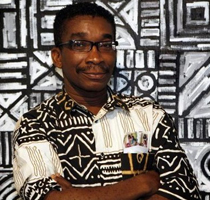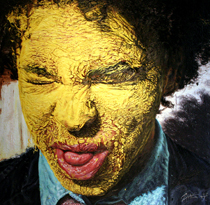In Guide – Contemporary African Art, (I have selected Nigeria, being one of African’s most populous states), seventeen pages were devoted to a listing of practicing artists in the country at the time, with about two hundred artists listed, as against three pages with twenty four listed artists living in the West – United States, Britain, Italy and Germany – at that time. Under my country Ghana, the artists listed in this directory are still the leading, actively practicing artists. The eighties and nineties in Ghana, in spite of all the political upheavals and economic woes, were actually the decades the arts really flourished. There were major exhibitions from month to month. That was the period Ghana’s pre-eminent artists, Ablade Glover and Ato Delaquis, made their mark and influenced a whole generation of young artists. I admit, they were unbearably difficult years. Conditions of living were very deplorable. As a painter, it was almost impossible to readily come by art supplies to sustain your practice. But we survived those years, all the same, and here we are.
From the few figures cited from the Nigerian section in Guide: Contemporary African Art, 1992-1994, the lop-sided proportion of home-based artists as against artists abroad, in Europe and the U.S.A, go for all the countries listed in the directory. Some countries did not have any artist at all living overseas. Only one or two war-ravaged countries, like Liberia and Somalia, where the compilers of the directory found it difficult to collect data, were left out in the directory, which I would describe as a fairly comprehensive guide to contemporary African art in the 1980s and the 1990s. It held a mirror to the demographics of continental-based African artists and those living and working in the Diaspora at the time. From the foregoing, I wonder the veracity in Okwui Enwezor’s claim that the flight en masse of African artists and art writers to the West in the 1980s and 90s when they had to escape unfavorable working conditions and, sometimes, political persecution, shifted the polarity of contemporary African art production and its scholarship to the West. This is a factual inaccuracy Enwezor is peddling. He does not have to throw dust into the eyes of his audience/readers and mislead them with mendacious claims.
I have always wondered who the influential art writers – always talked about by Okwui Enwezor – are who fled the economic deprivation and political instability and persecutions of the eighties and nineties to the West. We do not have much of an art critical writing culture here in Africa, in the first place, as exists in the United States and in Europe. I know Olu Oguibe had written a few good reviews in Nigeria before embarking on his exile, and did continue writing in London along-side his art practice and studies. I do not know of Okwui Enwezor as a writer of any stature in Nigeria (I stand to be corrected) before his migration to the West. I believe he honed his craft as an art writer and critic in the art world of New York and London. There could have been one or two others – Hassan Salah?, Dele jegede?, Gilane Tawadros?, Rasheed Araeen? or Simon Njami? Sylvester Ogbechie and Tumelo Mosaka are relatively new on the block. In any case, how could just a handful of people I could count on my five figures be used hyperbolically to justify the claim that masses of African artists and writers fled to the West? The noted writer on the visual arts of the Black-Diaspora and author of Welcome to the Jungle, Kobena Mercer (Dr.) was born in the U.K. to a British mother and a Ghanaian father. He grew up in the U.K., apart from his very early years in Ghana. Certainly, he could not have been part of the exodus, or flight from Africa. The curator of Fault Lines: Contemporary Africa Art and Shifting Landscapes and former director of Institute of International Visual Arts, U.K., Gilane Tawadros, moved from Egypt to Britain in 1970. Obviously, she could also not have been part of the exodus train Enwezor claims.
It is interesting to know that most of the artists listed throughout Guide – Contemporary African Art, apart from a few new names, are still the most prominent and actively practicing African artists in Africa or abroad today. Most of the art experts listed in the directory are still the experts or authorities around today. It is surprising and interesting I did not find Enwezor’s name in this list. Chika Okeke-Agulu was listed as a painter and sculptor – possibly a student or a lecturer at the time – on the campus of the University of Nigeria in Nsukka, Enugu State. The two editions of Nicole Guez’s directory, Guide – Contemporary African Art and, additionally, Bernice Kelly’s Nigerian Artists: A Who’s Who and Bibliography are two documentary evidences which should set the records straight, once and for all, that there was no mass migration of African artists to the West in the 1980s and 1990s as purported by Enwezor.
Of very-well-known Nigerian-born artists in circulation today, Sokari Douglas Camp, OBE, was not part of the exodus in the 1980s. She had always lived in the UK from her childhood, schooling in California at the California College of Arts and Crafts. Likewise Yinka Shonibare MBE; born in the UK in 1962, started growing up in Nigeria, and went back to the UK when he turned 16 to complete his graduate studies at Wimbledon College of Art, Bryn Shaw and the Goldsmith College. As mentioned earlier, he lives and works in London. Odili Donald Odita was born in 1963 in Enugu, Nigeria, but was raised in Columbus, Ohio. He earned his B.F.A. from Ohio State University, Columbus, Ohio in 1988 and his M.F.A form Bennington College, Bennington, Vermont in 1990 and now lives and works in Philadelphia. The Turner Prize Winner, Chris Ofili was born in 1968 in Birmingham to Nigerian parentage. He also grew up in the UK studying art at the Chelsea School of Art, 1988-91, and the Royal College of Art, 1991-93. In fact, Chris Ofili is regarded more a British artist than an African artist. And as much as possible, he himself likes to disassociate himself from Africa, or renounce his being African. I do not know why chroniclers of the history of contemporary African art are still intent on wanting to claim him as a son of Africa. I think he should be left to his faith. So, who were the African artists who moved to the West in the 1980s and changed the whole terrain of practice and discourse on contemporary African art, making the African Diaspora the World Capital of “Contemporary African art�
The empirical and verifiable evidence from Nicole Guez’s Guide – Contemporary African Art unequivocally, suggests otherwise, that there were no mass movements by African artists and art writers to the West in the 1980s and 1990s, that what Okwui Enwezor has always described as the exodus is a misinformation, exaggeration and figment of his own imagination. It is not the truth as it stands. It is spurious and misleading. Absolutely fallacious! Enwezor had to weave hard a seemingly credible story to validate his undue fixation with African Diaspora artists, and his own continual stay in the West. It is, however, only in the last few years that the number of young African artists who are migrating to the West, probably, have stepped-up, apparently because they do not see any bright prospects for themselves in Africa, all partly because of the politics of exclusion being perpetuated by Okwui Enwezor and his school. “To be visible and valued, my brother (sister), you have got to move to the West,†that is the maxim today.





Excellent article. While your focus seems to be visual art here, there seems to be a parallel trend in literary space. For example, most of the Nigerian writers known and celebrated globally are those in Diaspora, despite the fact that there is a thriving literary culture within the country.
I thoroughly enjoyed this piece. The discourse of home-based African art/artists versus exiled African art/artists in the 21st Century is one worth analysing.
Wemega-Kwawu has given us an insight into the world of those folks Stuart Hall (1996) described as “the deeply cultural character of the revolution of our times†(232).